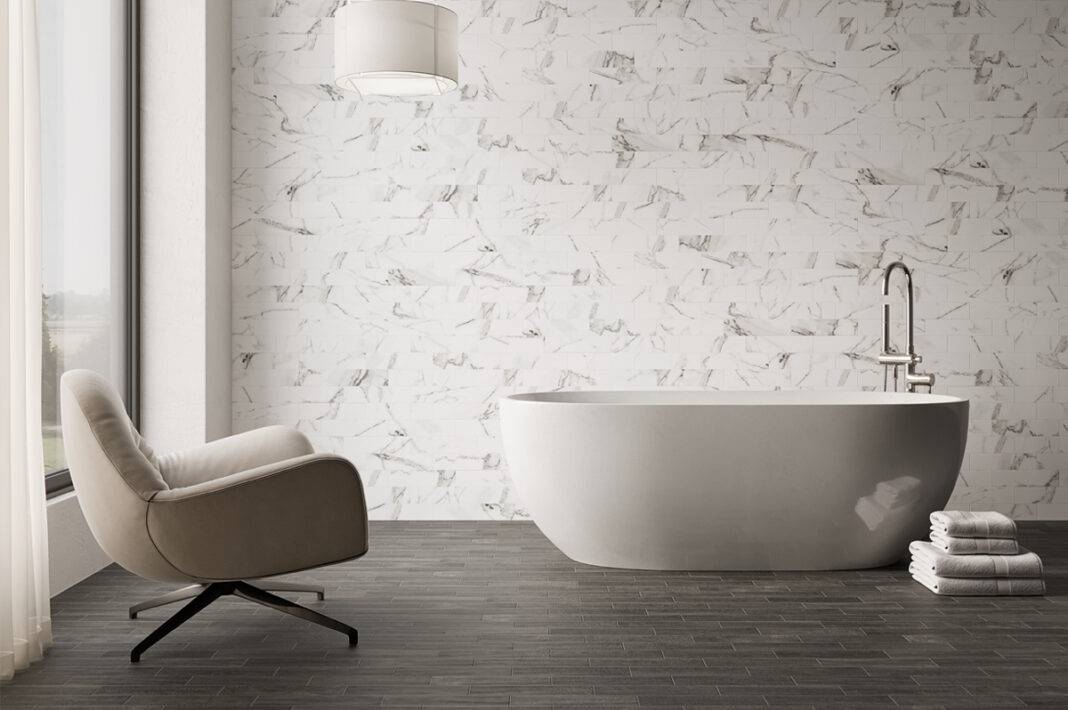With Cevisama delayed until June, Tile of Spain, the organisation that represents Spanish ceramic tile manufacturers, curates some of the freshest designs, formats and technologies from Spain that made the headlines in Bologna at Cersaie 2021.
As Europe’s largest tile producing nation by volume, and second ranked tile exporter, Spain remains a ceramic tile powerhouse and one of the trend-setting nations.
Spanish companies are major participants at Cersaie, the world’s foremost trade exhibition for ceramic and porcelain tiles and slabs. In 2021, despite the massive disruption caused by the global Coronavirus pandemic, the Spanish manufacturers once again came out in force. The group of over 80 Spanish companies at Bologna bore testament to the country’s commitment to export markets; as well as the global nature of the Italian fair and its visitors. It proved a good call because, in spite of continued uncertainty and various travel restrictions, visitor turnout was pretty strong.
At Cersaie, the contingent of Spanish ceramic manufacturers represented the second largest group by nation; with only the host nation, Italy, boasting more exhibitors from the total of 26 exhibiting countries.
There was a multitude of new trends, formats, and technologies on display from Spain at this long-awaited show.
As so many individuals across the globe have been forced to spend more time at home in the past two years, easy-care interiors have become more important than ever: as have outdoor spaces. Commercial environments have also needed a complete design rethink.
Ceramic tiles are not only aesthetically pleasing in terms of refreshing a décor, they are a safe and practical option: durable, hygienic, and water-resistant. These qualities were very evident in the impressive new crop of tile designs coming out of Spain.
To maximise the impact of participation at Cersaie, the Spanish Ceramic Tile Manufacturers’ Association (ASCER) created a dedicated web page – tileofspain-cersaie.com – as an on-line catalogue full of information on each of the exhibiting companies.
This site is still accessible. As well as contact information and images, the website showcases the new products that were presented by each exhibitor, and a simple company search function. The microsite was designed to offer simple and fast information from mobile devices.
Tile of Spain also supported the event with an advertising campaign, which was accompanied by an intense monitoring of the fair from the Instagram profile @tileofspain and the hashtags #TileOfSpainAtCersaie and #TileofSpainisback.
Spanish exports growth in 2021
Spanish tile exports in the first six months of 2021, made to 183 countries, reached €1,799.7 million, which represents a cumulative growth of 35.7% against 2020.
In comparison with the sales of 2019, excluding, of course, the effect of Covid, growth in the January-June period was 22.8%.
48.8% of exports (€878 million) went to European countries, of which 37.5% went to EU member countries. France stands out as the number one market, and main European destination, with an increase of 41.5%. Growth was strong, too, in other countries: notably United Kingdom (up 45.4%), Italy (up 50.3%), Germany (up 13%), Portugal (up 23%), and Belgium (up 31.3%). Outside of the EU, the USA is the main destination market, occupying the second place in the ranking with annual sales, up until June, of €210 million (up 34%).
Majestic marbles and terrazzo tones
While white marbles still reign supreme, more compelling crystallines like Macchia Vecchia and others have joined the likes of Calacatta and Statuary in Spain’s tile portfolio.
The strong and timeless look of rustic stone has taken somewhat of a back seat, upstaged by today’s refined selection of new marble-effect designs. This new approach retains the organic variation of a veined stone with an overall aesthetic that is more homogenic … a soothing symphony of texture, finish, and effect.
Richly striated marble, stone, and terrazzo effects continue to be popular. This is fuelled by the fact that the kitchen and bathroom industries have overcome any shyness about using designs that are obvious exaggerations of the raw material. Dramatic swirls of colour, and large fleck,s give porcelain wall and floor tiles the ability to transform any interior. The more out there and impressive the better.
Keeping pace with these mega-marbles is terrazzo, but with a broader range of chipped materials embedded in a largely monochrome matrix.
With multi-coloured inlays in varying degrees of chromatic variation, these aggregate collections work with marbles, woods and traditional ceramics alike. Drawing on the myriad of tones in the inset chips as colour and material references, this decorated motif invites designers to add layers to their compositions while keeping a cohesive feel.
Golden arches and natural elements
Art deco influences still abound in the form of arches and rounded corners. A nod to organic shapes, while retaining the straight grid-lines of a tile matrix, these curves bring a sense of whimsy and approachability to even the most austere and luxurious aesthetic.
The rise of earth tones is expanding to include all ranges of warm-inspired hues; from deep neutral browns, to warm greys and off-whites. These warmer tones lean into accompanying the raw and minimal timber looks that have grown in strength over the past few years, adding layers of texture for an inviting feel. Earth-tones tip the scale to the warm side, while accent colours continue to favour cooler greens and blues.
Modular formats and clean lines
Interchangeable, multi-format tile collections lean into the need to create flexible spaces at times, and define our boundaries at others; a task that can otherwise be difficult with a minimalist modern grid.
The modular format creates blurred lines that allows for reconfiguring a space as needed for multiple uses.
During this new era of ceramic design, a more delicate approach is running in parallel; with artisanal textures and organic materials.
Smooth compositions, hushed textures, and minimalistic patterns will lend a sense of balance. The seeming dissonance in style serves to highlight and praise differences by showcasing unlikely pairings throughout designs, revealing surprising harmonies.
Celebrating ceramics and colour
With digital technology progressing to a point that multiple finishes, structures, and volumes can be digitally applied, the industry is circling back to some intriguing classics from centuries past. One strand is ceramics that aren’t trying to imitate anything, instead honouring the rich and artisanal history of this material and industry. These design offer weathered edges, classic glaze techniques, and traditional patterns. This celebration of ceramic roots plays beautifully with all the preceding trends and is the perfect harmonic accompaniment to it all.
Colours come and go, of course, but it is predicted that a post-pandemic philosophy of going crazy, either with vibrancy of hue or the bold placement of tiles, will set the interior design agenda for some time to come.
New wave forms
Who doesn’t find waves at the shore to be uplifting? The Spanish tile manufacturers have plenty of inspiration along their coasts to fuel this trend. Undulating 3D lines can be deep and sculptural or more subtle, perhaps creating a calming effect.
Often seen on white tile formats, reliefs can be digitally printed with beige or gold veining, reminiscent of patterns in the sand and froth of the surf. As well as being flecked with colour, these surfaces may be textured or have a shimmering quality.
Mosaic magic
Many of the Spanish brands produce mosaic versions in their ranges, whether stone, cement or other material effects, but recent times have seen mosaics come into their own. There has been a resurgence of mosaics as the stand-out design in a series.
What’s more, mosaic specialists are also offering some truly sensational contemporary takes on the classic mesh-backed format featuring penny-shaped tessera.
There is always a counterpoint to any mainstream trend and products offering a soft look for interior and exterior settings will still account for a huge market share. Wood-effects and warm, earthy tones dominate and are often contrasted with simple white formats.
About Tile of Spain
In Spain, tile makers labour as they have for centuries – pushing their passion for design and innovation to new levels of artisanship. With one of the purest and strongest domestic clays available, Spanish manufacturers have an unparalleled ability to make the end product more diverse: from rustic hand-made forms; to technical façades that cool buildings and clean the air; to impossibly slim, sustainable, recycled and ink jet masterpieces that really fire the creative imagination.
The Spanish Ceramic Tile Manufacturers’ Association (ASCER) is the private organization whose primary objective is to support Spain’s ceramic tile manufacturers and the industry as a whole by stewarding and promoting the Tile of Spain brand worldwide.
Tile of Spain is the voice of the Spanish tile industry, encompassing more than 120 tile manufacturers. Renowned worldwide for an inspiring blend of aesthetic and technical innovation, Spanish tiles draw on a rich heritage of skill and creativity while remaining at the cutting edge of design.
More at: www.tileofspain.com









